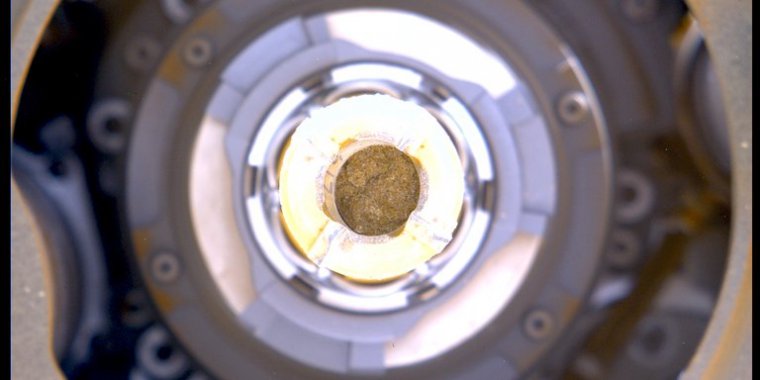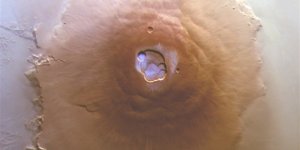| News / Space News |
Why Scientists Are Intrigued by Air in NASA’s Mars Sample Tubes
Atmospheric scientists get a little more excited with every rock core NASA’s Perseverance Mars rover seals in its titanium sample tubes, which are being gathered for eventual delivery to Earth as part of the Mars Sample Return campaign. Twenty-four have been taken so far.

This image shows a cylinder of rock the size of a piece of classroom chalk inside the drill of NASA's Perseverance rover. Each core the rover takes is about 0.5 inches (13 millimeters) in diameter and 2.4 inches (60 millimeters) long. Photo: NASA/JPL-Caltech/ASU/MSSS
Most of those samples consist of rock cores or regolith (broken rock and dust) that might reveal important information about the history of the planet and whether microbial life was present billions of years ago. But some scientists are just as thrilled at the prospect of studying the “headspace,” or air in the extra room around the rocky material, in the tubes.
They want to learn more about the Martian atmosphere, which is composed mostly of carbon dioxide but could also include trace amounts of other gases that may have been around since the planet’s formation.
“The air samples from Mars would tell us not just about the current climate and atmosphere, but how it’s changed over time,” said Brandi Carrier, a planetary scientist at NASA’s Jet Propulsion Laboratory in Southern California. “It will help us understand how climates different from our own evolve.”
Among the samples that could be brought to Earth is one tube filled solely with gas deposited on the Martian surface as part of a sample depot. But far more of the gas in the rover’s collection is within the headspace of rock samples.
These are unique because the gas will be interacting with rocky material inside the tubes for years before the samples can be opened and analyzed in laboratories on Earth.
What scientists glean from them will lend insight into how much water vapor hovers near the Martian surface, one factor that determines why ice forms where it does on the planet and how Mars’ water cycle has evolved over time.
Scientists also want a better understanding of trace gases in the air at Mars.
Most scientifically tantalizing would be the detection of noble gases (such as neon, argon, and xenon), which are so nonreactive that they may have been around, unchanged in the atmosphere, since forming billions of years ago.
If captured, those gases could reveal whether Mars started with an atmosphere. (Ancient Mars had a much thicker atmosphere than it does today, but scientists aren’t sure whether it was always there or whether it developed later).
There are also big questions about how the planet’s ancient atmosphere compared with early Earth’s.
The headspace would additionally provide a chance to assess the size and toxicity of dust particles — information that will help future astronauts on Mars.
In 2021, a group of planetary researchers, including scientists from NASA, studied the air brought back from the Moon in a steel container by Apollo 17 astronauts some 50 years earlier.
“People think of the Moon as airless, but it has a very tenuous atmosphere that interacts with the lunar surface rocks over time,” said Simon, who studies a variety of planetary samples at Johnson. “That includes noble gases leaking out of the Moon’s interior and collecting at the lunar surface.”
The way Simon’s team extracted the gas for study is similar to what could be done with Perseverance’s air samples. First, they put the previously unopened container into an airtight enclosure.
Then they pierced the steel with a needle to extract the gas into a cold trap — essentially a U-shaped pipe that extends into a liquid, like nitrogen, with a low freezing point. By changing the temperature of the liquid, scientists captured some of the gases with lower freezing points at the bottom of the cold trap. (NASA)
YOU MAY ALSO LIKE





